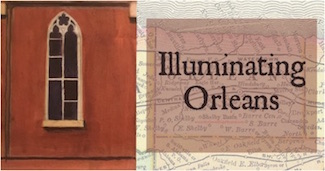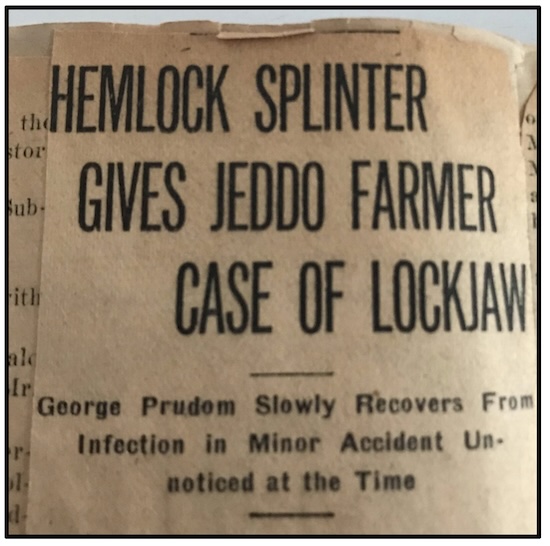Tetanus from hemlock timber left Jeddo man with lockjaw a century ago
By Catherine Cooper, Orleans County Historian
“Illuminating Orleans” – Volume 5, No. 6

Dr. Thurman of Lyndonville was called, he suspected lockjaw, but Mr. Prudom could not recall having received a scratch of any kind that might have caused the infection.
Dr. Russell, a specialist from Buffalo, was consulted. He agreed with the lockjaw diagnosis and prescribed a lockjaw serum treatment which was effective and after a week, Mr. Prudom was able to open his jaws slightly. He recovered fully after some time.
Upon reflection, the only incident that Mr. Prudom could recall was that a short time previously, he had been handling a heavy piece of hemlock timber which had fallen on his foot. At the time, the injury was slight, and Mr. Prudom paid no attention to it. He surmised that the infection may have been caused by a scratch from a hemlock splinter.
However, hemlock trees are not poisonous, so Mr. Prudom’s lockjaw was not caused directly by the hemlock log but was most likely the result of an infection caused by tetanus spores entering through a cut or scratch occasioned by the fall of the log onto his foot.
Hemlock trees are native to this area and were growing in abundance when the first settlers came here. They used hemlock splints for the roofs of their log cabins. Lacking furniture, they made comfortable beds from hemlock boughs laid on the floor and covered with blankets.
When laying the first roads from Ridge Road to the lake, Jeremiah Brown, the first Commissioner of Highways in the Town of Ridgeway wrote: “We would lay a road, following the lines between lots to the lake, keeping us busy all day. At night, we would make a fire, cut some hemlock boughs for bed and sleep soundly all night.”
There is a plant known as poison hemlock which is highly toxic to humans and animals. It contains coniine, an alkaloid capable of inducing paralysis. Hemlock trees and the poison hemlock plant are unrelated, they share a name because their leaves emit a similar odor. The roots of this plant were an ingredient in witches’ brew in Shakespeare’s Macbeth: “Root of hemlock, digg’d in the dark”
Hemlocks are large pyramid-shaped evergreen trees which resemble Christmas trees. They can attain a height of 60 – 70 feet. There must once have been a significant stand of hemlocks on the road which was named Hemlock Ridge Road which runs east-west through the Towns of Shelby and Barre. Some hemlocks may still be seen along the road. Hemlock trees may also be found in Mt. Albion Cemetery.


































































